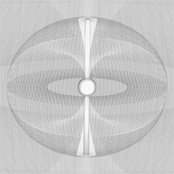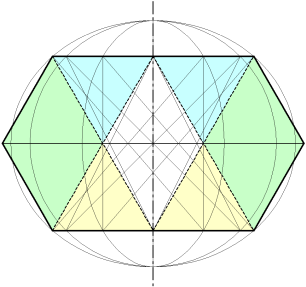



































conceptual inquiry regarding meaning » reality » self/world dynamic
While experiencer is paradigmatically self, and experienced is paradigmatically world, experiencing is paradigmatically the dynamic relationship therebetween. This dynamic is a tension that keeps self and world connected even as it holds them apart.  Diagrammatically (shown to the right), the bases of the interpenetrating self and world cones turn back toward their common hidden horizon and meet at the plane of some continuum—call it the physical universe (so long as we don't think of physicality as made up of heaps and lumps but something closer to the electric/dynamic, materio-causal nexus it appears to be). Self then diagrammatically becomes the axis, connecting the apexes of the interpenetrating cones, while world becomes the unified base at the hidden horizon. The axis locates a part—always at the center—while the horizon represents the whole. Dynamic, then, becomes the part-to-whole dialogical activity that interprets self and world (part and whole) as distinct even while maintaining their dynamic unity. Dynamic is thus diagrammatically a torus. That which appears within the inner circle (where the self and world cones interpenetrate) is foregrounded experience, while the outer circle horizon represents the background coincidence of self and world against which foregrounded experience can appear. The entire system of intelligibility is in this way self-contained.
Diagrammatically (shown to the right), the bases of the interpenetrating self and world cones turn back toward their common hidden horizon and meet at the plane of some continuum—call it the physical universe (so long as we don't think of physicality as made up of heaps and lumps but something closer to the electric/dynamic, materio-causal nexus it appears to be). Self then diagrammatically becomes the axis, connecting the apexes of the interpenetrating cones, while world becomes the unified base at the hidden horizon. The axis locates a part—always at the center—while the horizon represents the whole. Dynamic, then, becomes the part-to-whole dialogical activity that interprets self and world (part and whole) as distinct even while maintaining their dynamic unity. Dynamic is thus diagrammatically a torus. That which appears within the inner circle (where the self and world cones interpenetrate) is foregrounded experience, while the outer circle horizon represents the background coincidence of self and world against which foregrounded experience can appear. The entire system of intelligibility is in this way self-contained.
But I'm getting ahead of myself. To complete the formal analysis of experience as such, we must address that which is paradigmatically dynamic as experiencing as such and ask How is experiencing shown as self, dynamic, and world? But before we can do that, it's important to consider the difference between experiencer and experienced on the one hand and experiencing on the other. Experiencing is fundamentally an activity—a process. It's not an entity or thing expressed as a process; it's by nature a process. It's a process that stretches out toward experience. Such a process might be most basically understood in terms of attention, from [L] attendere, literally "to stretch toward" (etymonline.com). The process of experiencing as a stretching toward experience opens a space where meaning can occur between experiencer and experienced.
Returning again to the difference between experiencer and experienced on the one hand and experiencing on the other... If we were to draw an analogy between this difference and parts of speech, experiencer and experienced are to nouns as experiencing is to verbs. To extend this analogy, we might think that self, dynamic, and world modify experiencer and experienced similar to the way adjectives modify nouns, while they modify experiencing similar to the way adverbs modify verbs. So, when we consider experiencing as self, for example, we don't mean the self is experiencing or experiencing as if from the point of view of one's self; we mean something like experiencing self-ly, and, as self and world bear a relationship to each other analogous to that of part to whole, by experiencing self-ly we would mean something like attending to parts, or, more precisely, attending in a focused mode, narrowing the scope of attention. Likewise, by experiencing as world—i.e., experiencing world-ly—we'll mean something like attending to wholes, holistic attending, or, more precisely, attending in an open/receptive mode, broadening the scope of attention. It follows that by experiencing as dynamic we may mean something like attending in a rhythmic mode, actively reconciling (in real time) dynamic parts with dynamic wholes.
| W | experiencing as such | |||
| experiencing | ...as self | ...as dynamic | ...as world | |
(These modes of attending will be addressed more fully under the O-phase and its nodes.)
